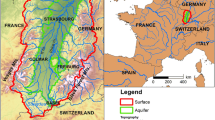Abstract
The representation of hydrological land surface processes has, so far, been treated inadequately in global models of the atmospheric general circulation (GCMs). In particular the lateral waterflows from the continents into the ocean have been described unsatisfactorily. The aim of this study is to develop a model for the lateral waterflow on the global scale which describes the translation and retention of the lateral discharge as a function of the spatially distributed land surface characteristics that are globally available. Here, global scale refers to the resolution of 0.5° and smaller, corresponding to a typical GCM gridbox area of about 2500 km2. Discharge models need a number of specific input variables that are usually not available from measurements such as runoff and drainage. Therefore, these variables have to be derived from observed data such as precipitation and surface air temperature. For the model development in this study, a new simplified land surface scheme was applied to compute these variables. The discharge from a catchment of approximately the size of a 0.5° gridbox was simulated using several types of models. The intercomparison of the simulated lateral flows of the different models shows that as a minimum a separation between flow processes such as overland flow, baseflow and riverflow is required to yield good discharge simulations. As both the retention and translation of a flow process need to be simulated, a two-parameter model is required for the representation of overland flow and riverflow. For the baseflow, a one-parameter model is sufficient. The resulting model structure is called the hydrological discharge model or HD model. A first parametrization approach was defined using the gridbox characteristics of topography gradient and gridbox length. The skill of the discharge simulation depends not only on the formulations of the model, but also on the precise definition of the boundaries of the model catchments. The sizes and the positioning of the model catchments on the globe were defined by using a river direction file as well as a modified topography dataset. In a first application, the HD model successfully simulated river discharge using runoff and drainage from a five year atmospheric GCM integration (ECHAM4-T42) as input. The annual cycles of the monthly means of the simulated discharge of several large rivers were compared to the observed discharges provided by the Global Runoff Data Centre. The HD model achieves a considerable improvement of the simulated discharge compared to the model which is currently operational at MPI. The improved volume of the discharge is directly related to the definition of more realistic model catchments and the improved timing of the flow is mainly due to the newly introduced separation of the flow processes.
Similar content being viewed by others
Author information
Authors and Affiliations
Additional information
Received: 20 November 1996 / Accepted: 8 July 1997
Rights and permissions
About this article
Cite this article
Hagemann, S., Dümenil, L. A parametrization of the lateral waterflow for the global scale. Climate Dynamics 14, 17–31 (1997). https://doi.org/10.1007/s003820050205
Issue Date:
DOI: https://doi.org/10.1007/s003820050205




